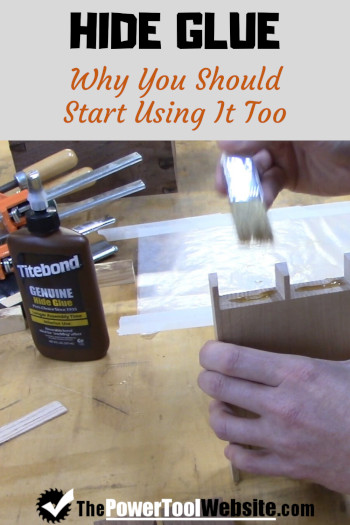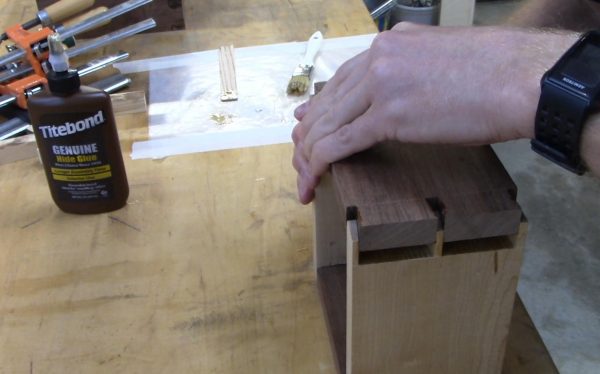

Hide glue gets its name from the fact that it comes from animal hides, bones, hooves… (I’ll stop there).
It’s a very archaic glue that’s been around as long as woodworking has. But even still, today’s hide glue creates just as good of a bond as PVA wood glues.
Read more about PVA wood glue here.
Traditional hide glue is pliable when it’s heated up, and as it cools it becomes very adhesive. Once it fully dries, the bonding is incredibly strong.
This type of glue is typically used with a hot pot that holds the glue at a certain temperature (usually about 140 degrees F). It cools quickly becoming tacky, and fully dries at around 24 hours.
The point is, traditional hot hide glue can be difficult to work with, and so is avoided by most woodworkers (understandably so).
But there’s another option.
Liquid hide glue, specifically the stuff Titebond came out with, works just fine at room temperature, plus it has a long open time.
Even though it may not have quite the bonding strength traditinoal hot hide glue has, it still produces a glue joint stronger than the wood itself.
That means it’s still plenty good for wood projects and if used and applied properly, should create joints that last a really really long time.
Hide Glue Advantages
The biggest benefit of hide glue is that it’s reversible.
Yes, you can reactivate the glue by applying heat and moisture to the joint. This is probably the biggest reason it’s used in woodworking.
It’s like having an “Undo” button on your project. If a mistake were made during a glue up, you can actually back up and fix it. And we all know the same just can’t be said with other wood glues…
Another benefit that I love is that it sets up hard so it can be sanded, scraped, and cut easily.
Glue squeeze out can be a pain to work with and eliminate from intricate glue ups and inside corners.
And some wood glues heat up and become soft or sticky when sanded, making it impossible to sand away completely. This simply isn’t an issue with hide glue.
Over at Popular Woodworking, they did some tests comparing the 2 leading liquid hide glues (Old Brown and Titebond). Their findings were that they are both great contenders and held their own in various tests of strength, reversibility, and ease of use.
The English Woodworker posted an article as well. He uses Titebond hide glue a lot, and his biggest reason is because the glue makes it easier to slide the joint together.
Think about it. A tight glue joint, especially a complicated one with multiple simultaneous joints using PVA glue, starts to stick and sometimes require a little extra finesse from a rubber mallet.
But with hide glue, it stays open longer, and slides really well, making the initial lining up of the joints easier.
Plus it’s not water-based, meaning it doesn’t swell the wood fibers (another reason PVA glue joints get tight so quickly).
And as Christopher Schwarz also wrote on the Popular Woodworking website, he uses Titebond hide glue for almost all his basic joinery needs, and loves it.
He even added that he simply microwaves it for 13 seconds if/when he ever has a need for hot hide glue.
And finally, yes it has a long open time (liquid hide glue, not hot hide glue). It can be applied to very complicated glue ups that require a lot of different glued surfaces (like a dovetail box).


And once you’re finally ready to clamp everything together, the glue is still slippery and ready to go.
Hide Glue Disadvantages
It is not water resistant. In fact if it gets wet, the glue may reactivate and potentially let loose a joint.
If you are using a hot hide glue (the kind you have to melt) you may find it very smelly. Liquid hide glues do not smell very strong at all, so they’re easier to be around.
Also if using the hot hide glue variation, you’ll find that it has a faster tackiness because as it cools down it becomes very adhesive.
And even though Old Brown liquid hide glue technically does not need to sit in a hot pot to activate it, you still may find it difficult to work with in a cold wood shop. It helps to have the glue warmed up a bit to help it flow better.
But this is easily achieved by placing the bottle in a bowl or large cup of hot tap water. A few minutes of this will do the trick every time.
And if you use Titebond, you shouldn’t have this problem at all, it’s supposed to flow well even down into the 60s.
When And When Not To Use Hide Glue
Antique furniture and instruments both have a need for disassembly (repairs and maintenance). So hide glue is definitely handy for these types of projects due to its reversibility.
Complicated glue ups that require longer open time (working time) would be made simpler using hide glue.
Any kind of joint that fits tight and would be hard to clamp together if/when the wood swells using PVA glue, then hide glue may be the ticket.
If there are inside corners in your glue joints, which will have squeeze out that’s very difficult to remove, hide glue can be helpful. This is because it (specifically Titebond) dries dark and is stainable. So if you can’t remove all remnants of squeezeout, it’s easier to make it blend in and match the wood color by staining.
However, hide glue is NOT water resistant. It’s also susceptible to microorganisms.
For these reasons, I would not suggest using hide glue for kitchenware or dining/eating tables.
As for me…
I think going forward I will be using Titebond’s hide glue more often in my projects.
I’ve found that working with pine (as I do quite often), dried PVA glue squeeze out is difficult to see. And the fact that PVA will not stain with the wood, it makes itself incredibly noticeable after I apply the stain to a glued up project.
Hide glue makes all of that much less of a problem.
And because I finish my projects (typically) with polyurethane. This will protect the glue joints from moisture if something is spilt on them. So I won’t have to worry about ‘accidental reversal’.
Be sure to sign up below to get updates on blog posts like this one, plus I’ll send you some free plans.
Related:
PVA Wood Glue – What’s It Used For And Why It Works
How To Choose The Best Glue For Wood Projects
Woodworking For Beginners – Tools, Projects, and Techniques